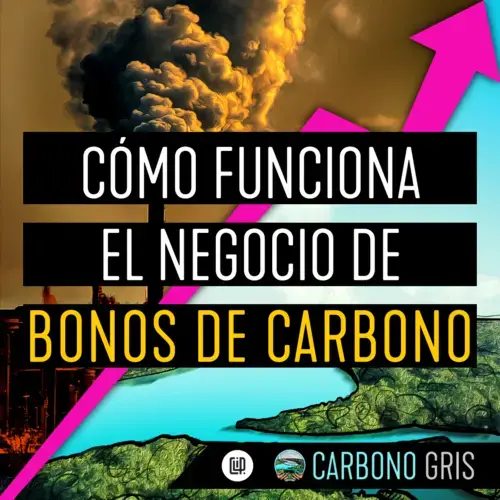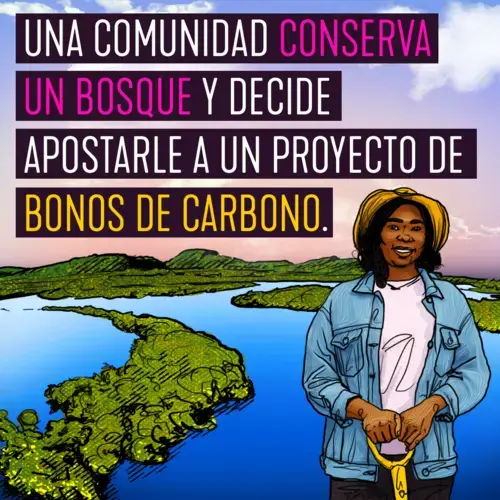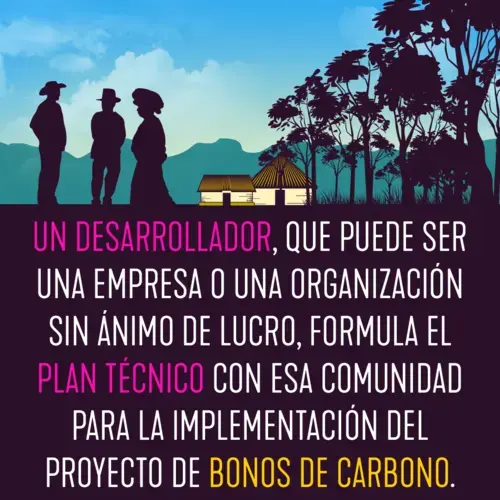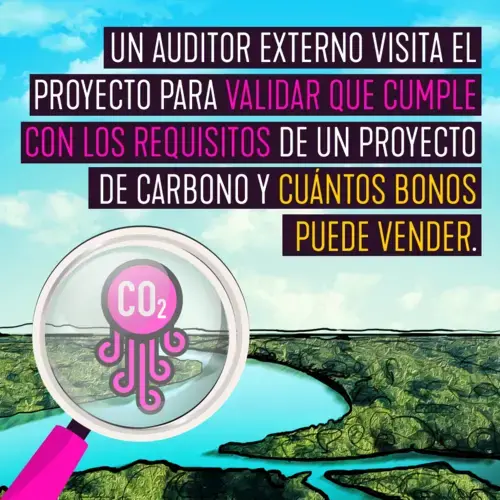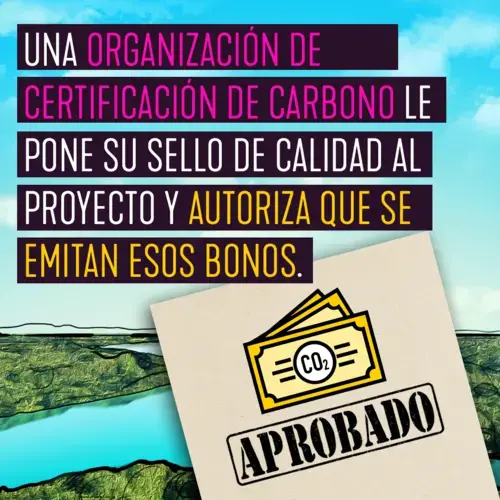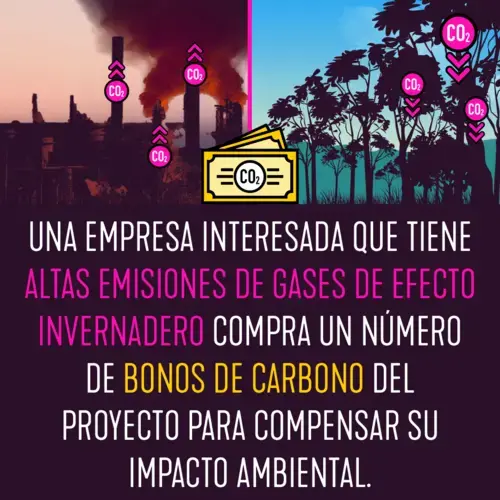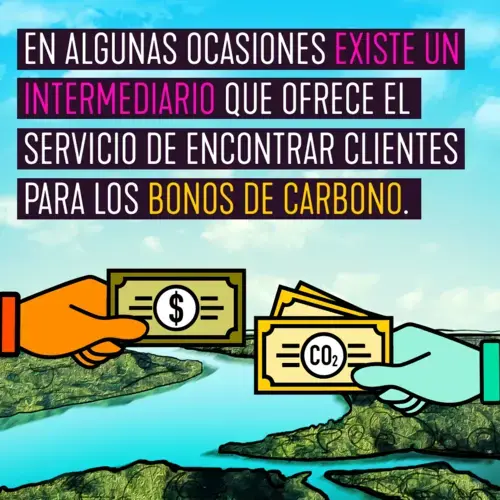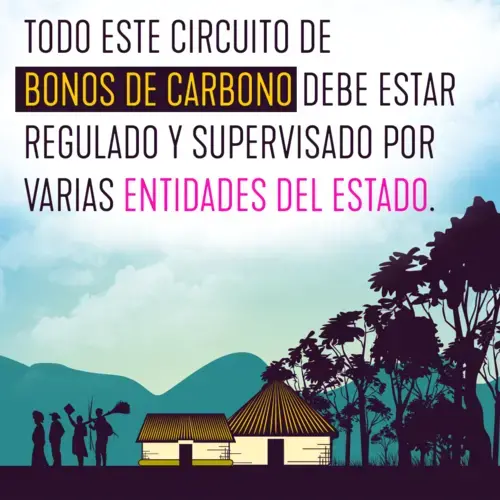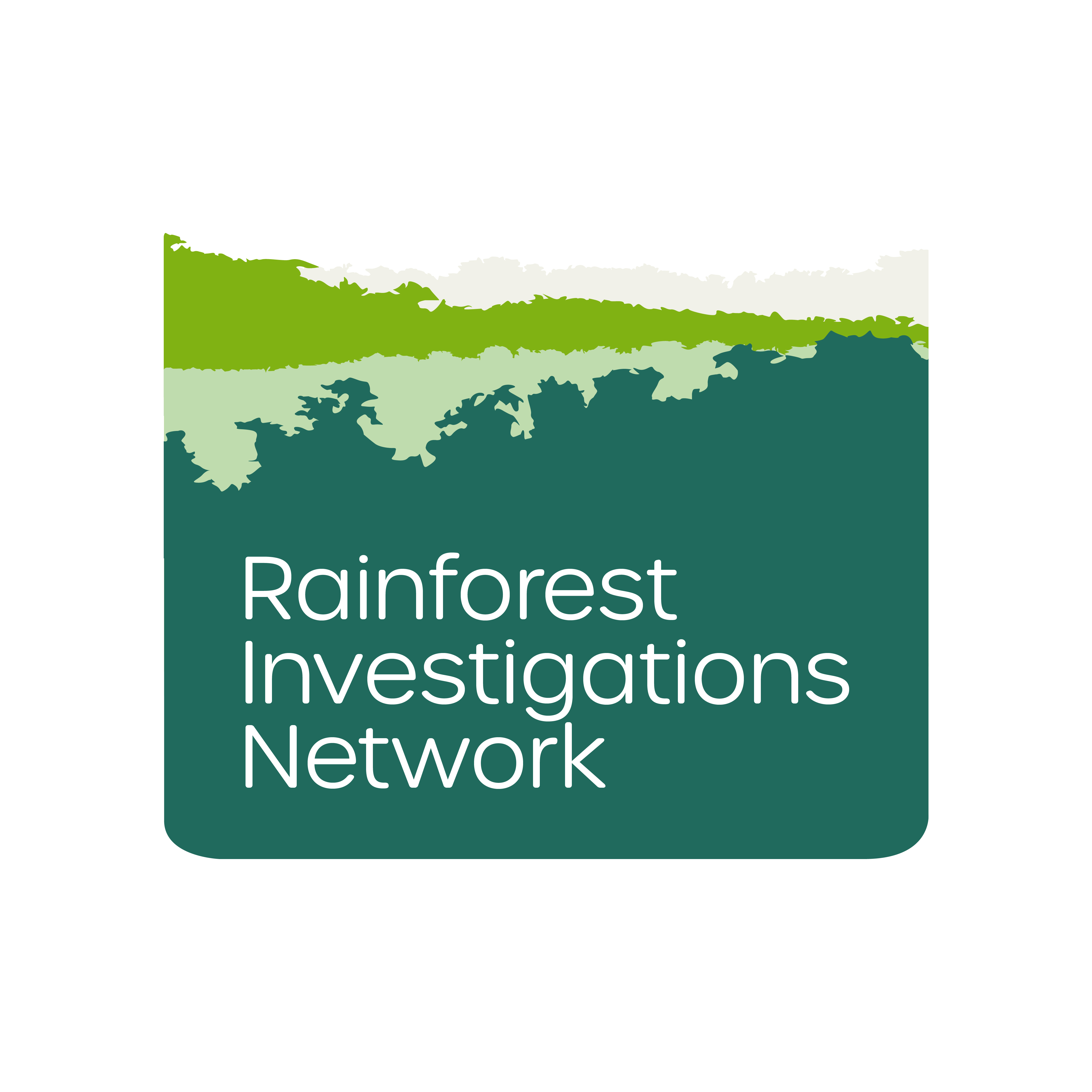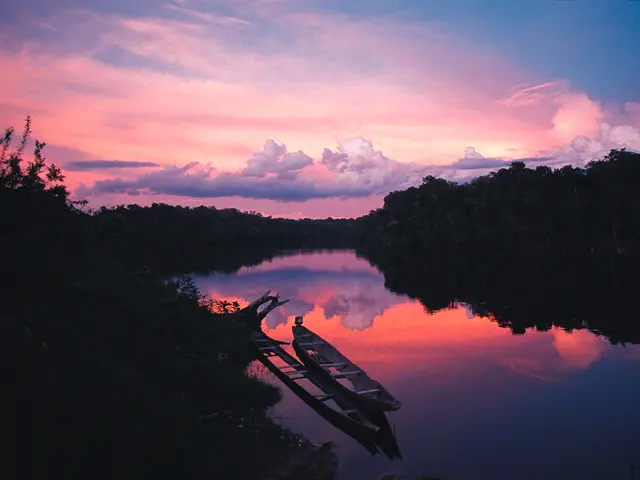
A group of Indigenous leaders is asking the Colombian justice system to invalidate a carbon credit project in their territory in the Amazon claiming that the person who signed it on their behalf was no longer authorized to do so. They want the case to reach the Constitutional Court, which could establish precedent on the obligation to protect the most vulnerable link in this and other green markets. In addition to some Indigenous communities of the Pirá Paraná, the project is also benefiting several companies, including one that sold the credits and has links to the project’s certifier, and another that received 40 percent of the revenues. What is not yet clear is how much is left to each party.
Indigenous authorities of the Pirá Paraná River, a vast jungle territory in the Colombian Amazon, went to court in July of this year to seek the annulment of a contract to develop a carbon credit project there called Redd+ Baka Rokarire.
Though the contract could bring them invaluable resources to continue preserving their corner of the world’s largest tropical forest, the leaders of the Pirá Paraná Indigenous Council and the Association of Indigenous Traditional Authorities of the Pirá-Paraná River (Acaipi) are upset, they told the judge, because they never approved the project being developed by Masbosques Corporation in their communities in southern Vaupés.
Moreover, they claim that the person who signed the legal document on behalf of the Indigenous territory with this environmental NGO from Antioquia in March 2021 had left his position two weeks before signing and was no longer their legal representative.
For this reason, they filed a protection action requesting the guardianship of three fundamental rights that, in their view, were violated by the NGO and three companies that promoted or validated the Redd+ Baka Rokarire project, as well as one national authority that should ensure the proper functioning of such environmental services schemes. “Their actions and omissions in the registration, formulation, validation, verification, certification, monitoring and follow-up of the initiative,” they wrote in their legal action, “are seriously violating our fundamental rights to cultural integrity, self-determination, self-government and territory.”

Whistleblowers and others in possession of sensitive information of public concern can now securely and confidentially share tips, documents, and data with the Pulitzer Center’s Rainforest Investigations Network (RIN), its editors, and journalists.
Masbosques, the NGO developing the project and including several public entities as partners, claimed before the judge that the change in leadership in Acaipi, in early 2021, had taken place after signing the contract and so the person who signed it was in fact their legitimate legal representative at that time. Therefore, they insist, their project complies with the sector’s social and environmental standards. “Masbosques acted with sufficient diligence and its actions were in accordance with the legal reality of the moment and consequently it cannot be claimed that [...] fundamental rights were violated or even put at risk,” they told the judge. At least 9 of the 17 Indigenous communities of the Pirá Paraná support Masbosques’ version and defend the current Redd+ project, underscoring that what should have been an environmental solution that brings them together has ended up dividing the community and fracturing its collective governance.
This conflict between the Antioquia-based NGO and the leaders of Acaipi is not the first to arise in Colombia’s voluntary carbon market, a promising financial mechanism that rewards communities that avoid deforestation by giving them the opportunity to turn this delicate mission into a paid job. As reported in other journalistic investigations led by the Latin American Center for Investigative Journalism (CLIP), other projects in the Colombian Amazon may be overstating their environmental results or have generated conflicts within the communities involved.
This dispute, however, could have an impact beyond the boundaries of the Pirá Paraná. Although the suit was denied in first instance and last week in second instance, the plaintiffs seek to make it the first case on the carbon market to reach the Constitutional Court. If selected by justices, the case could end up setting a legal precedent on the red lines that private parties should not cross when negotiating carbon offset projects with constitutionally protected—and often vulnerable—communities such as the Indigenous peoples of the Amazon.
This investigation by CLIP, Mongabay Latam, and La Silla Vacía, with support from the Pulitzer Center’s Rainforest Investigations Network, also found that—although the project is being led by Masbosques, a non-profit organization—at least one private company has made a profit from the business, and there is no transparency as to whether other companies have benefited, or in what way. Reporting by this group of media outlets as part of a broader investigation into the way this climate solution is functioning found that the company that sold the credits is connected to the persons behind the firm that certified the project, and that a third company may be receiving up to 40 percent of the proceeds from the sale of the credits, according to information from the NGO.
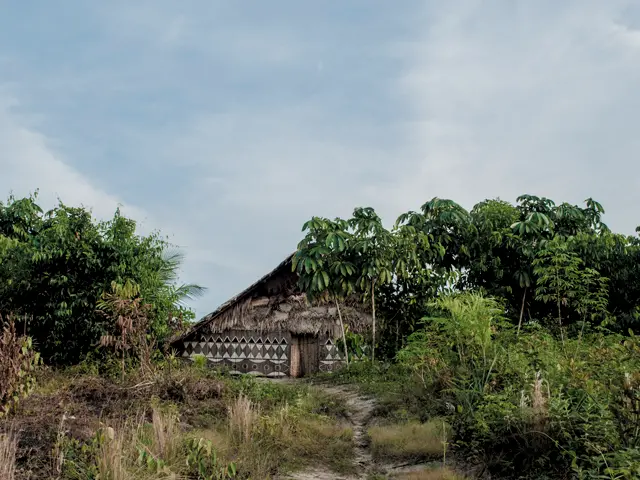
Pesos To Keep the Jungle in Place
Redd+ schemes—which have been officially incorporated into the United Nations Convention on Climate Change—seek to preserve strategic forests to mitigate the global climate crisis by linking national governments that are slowing deforestation with others that want to pay for those results. Each protected forest absorbs tons of carbon dioxide, one of the greenhouse gases that drive climate change.
Colombia has emerged as a global pioneer in promoting such large-scale initiatives, not only because it is home to 600,000 square kilometers of forest—an area the size of Ukraine—but because it has two other factors in its favor.
First, a large part of its forests is guarded by afro-descendant and Indigenous communities. Environmental management by the world’s Indigenous communities is so important that Project Drawdown, which brings together hundreds of scientists from around the world, ranked it as one of the 100 most effective solutions for limiting climate change. Following this logic, the Colombian government launched an innovative state-led Redd+ program in 2016 called Vision Amazonia, whereby three European countries pay Colombia an annual sum proportional to results in its fight against deforestation. The money is then shared between Indigenous communities, farmers, and government entities in the environmental sector. Attracted by the fact that in Colombia these ethnic minorities often have collective ownership and effective governance of their territories, many companies began to launch private carbon projects which, as CLIP has found, sometimes overlap, and compete with the state-run program.
Secondly, since 2017 the Colombian government created tax incentives to boost the carbon market, allowing companies that use fossil fuels to reduce or not pay their carbon tax through the purchase of credits. A credit typically offsets the emission of one ton of carbon dioxide (CO2).
These two advantages have led to a boom in private Redd+ projects throughout the country, concentrated mainly in the tropical forests of the Amazon and the Pacific, but also in the Caribbean mangroves, the Andean peatlands, and the grasslands of the Orinoquia. As of September this year, before it was no longer accessible to the public due to maintenance, the Environment Ministry’s platform had almost 90 Redd+ initiatives registered, in different stages of progress or implementation.
The dense and almost inaccessible Pirá Paraná rainforest, where the Pirá Paraná Indigenous Council and the Association of Traditional Indigenous Authorities of the Pirá Paraná River (Acaipi) govern, meets the perfect conditions for developing a payment for environmental services mechanism.
Carbon Credits in the Land of the Jaguar
Framed by the Apaporis River and the Brazilian border, the Pirá Paraná is an anchor-shaped territory covering 600,000 hectares (about 6,000 square kilometers), as large as Palestine or the Indonesian island of Bali. The “river of fish”, its name in the Makuna language, crosses it from north to south, passing through most of its 17 communities and 35 isolated malokas, before flowing into an Apaporis that meanders into the Caquetá and then the Amazon.
Its forests are in optimum degree of conservation due to their isolation, and can only be reached by a one-hour charter flight from Mitú or a week-long boat trip connecting rivers and streams. The region is so inaccessible that, faced with violence from rubber tappers in the early 20th century, Indigenous people retreated deep into the jungle and prevented outsiders from entering for decades, according to British anthropologists Brian Moser and Donald Tayler, who made dozens of audio recordings and a documentary for the British Library’s sound archive in the 1960s.
It has been historically so remote that, even today, few scientific expeditions have been made to its ecosystems. The herbarium of the Sinchi Institute, in charge of studying Amazonian biodiversity, has only 107 records in the area: 18 of these were collected in the 1940s by the American ethnobotanist Richard Evans Schultes—who inspired the famous film Embrace of the Serpent—and the remaining 67 during a Sinchi expedition in 2009. As a result of this last trip, which served as scientific support for the creation of the neighboring Yaigojé-Apaporis National Park, botanists Julio Betancur and Dairon Cárdenas identified 12 species of plants new to science and 49 new ones for Colombia in the Pirá Paraná and surroundings.
Isolation allowed the 2,000 Indigenous people of Pirá Paraná to preserve not only the Amazon rainforest, but one of Colombia’s most unique cultural practices: a traditional knowledge system known as the Jaguar Shamans of Yuruparí, designated by Unesco as Intangible Cultural Heritage of Humanity in 2011 and which they share with three neighboring territories.
In the cosmogony of the seven groups that coexist there (the Makuna, Barasana, Eduria-Taiwano, Tatuyo, Itana, Tuyuca and Carapana), the knowledge transmitted to them by their mythical ancestors—which they call Hee Yaia Keti Oka—is what allows them to take care of their territory and regulate relations between humans and the environment. They do so with rituals and practices they have carefully safeguarded, including shaman healings, an agro-ecological calendar that announces both physical and spiritual tasks to be performed throughout the year, and ceremonies in which—dressed in fibrous dresses and ochre-colored masks—they dance and sing to the sound of their sacred trumpets.
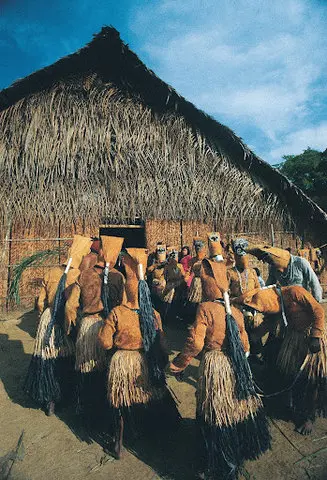
“It’s an encoded catalogue of knowledge put into practice through rituals and their ongoing performance is what keeps ecology going round. We don’t have to understand in the exact sense how a dance ensures the migration of fish, but these mythological narratives and religious practices guarantee that they don’t have a damaging effect on the forest but rather preserve it”, says Stephen Hugh-Jones, a British social anthropologist and professor emeritus at Cambridge University who has worked with the Indigenous people of Pirá Paraná since 1968. Both his doctoral thesis and that of his wife Christine are considered classic works on the north-western Amazon.
In other words, the strength of their cultural system has been one of the keys to the governance—and future—of that corner of the Amazon rainforest.
Two Legal Representatives, Two Weeks, and One Contract
On February 20, 2021, the leaders of the Pirá Paraná Indigenous Council met in the community of Santa Isabel, on the banks of the Comeña stream—one of the small tributaries of the Pirá Paraná—very close to the Brazilian border. The captains of 16 of the 17 communities and three wise elders were there.
That day they made the decision to change the legal representative of Acaipi, the Indigenous association that has brought them together for almost three decades: it would no longer be Eduria leader Jhon Fredy Benjamín Londoño. Instead, Tatuyo leader Jesús Alberto León Marín would take his place for the following four years, according to a document presented alongside the court proceedings.
From that date on, León would have the “power to manage projects that favor the different sectors of education, environment, health and other programs”, according to the document signed by 16 of the Indigenous people, four of them using fingerprints. While this change was officially registered by the Ministry of the Interior, they agreed that Benjamín “will give [his successor] a special power of attorney to sign the agreements and documents related to the Association of Traditional Indigenous Authorities of the Pirá Paraná River (Acaipi)”.
However, according to the Pirá Paraná’s current leaders, a year and two months later they learned that Benjamin, their former legal representative, had signed a contract for a carbon project with Masbosques shortly after the assembly in Santa Isabel. He did so—they argue in their legal action—thirteen days after the communities had removed him from his role of authority. “Position that, we insist, he no longer occupied,” they wrote in their lawsuit, to which they attached twenty supporting documents.
Indeed, on March 2, 2021, Jhon Fredy Benjamín and Jaime García Urrea, executive director of Masbosques, met in the community of Sonaña—in the upper Pirá Paraná—to stamp their signatures on a mandate contract with which they initiated a joint carbon credit project in the territory under the authority of Acaipi.
They presented it as an advantageous agreement for both: Masbosques, they wrote in the legal document to which this journalistic alliance had access, “wishes to implement a carbon project in the departments of Guainía, Guaviare and Vaupés” and is recognized “for the implementation of other successful initiatives for the preservation of strategic ecosystems in the region”, while Acaipi “is interested in participating in the development of the Redd+ project”.
In the contract, Acaipi authorized Masbosques to “advance the necessary steps for the implementation of the project” and agreed that its economic benefits would reach the communities “through sustainable productive enterprises, payments for long-term environmental services or the financing of actions to increase local forest governance, through a transparent process of consultation and effective participation”. They agreed that the term of the contract would be for an initial period of 10 years, which could be extended, but they did not detail how these profits would be shared and what share would correspond to each party.
Thus was born Baka Rokarire ~ia tir+~dito—which means “taking care of the forest” in three of the local languages. In addition to Pirá Paraná, the project includes five communities in the neighboring municipality of Taraira, on the other side of the Yaigojé-Apaporis National Park. Its promoters estimate that it could prevent the emission of 15.7 million tons of greenhouse gases in 30 years—or 526,000 each year.
The project was swiftly approved in the first two months of 2022. On January 17, Masbosques filed the final version of the project design document (or PDD, in industry jargon) with Cercarbon, according to the certifier’s platform. Almost a month later, on February 10, U.S. auditor Ruby Canyon Environmental verified that it had reduced 1.3 million tons of greenhouse gases between 2018 and 2020. The next day, on February 11, Cercarbono certified that it had an equal number of credits to sell. Seven weeks later, on March 31, they made their first sale.
Baka Rokarire was a reality.
An NGO from Antioquia Arrives in the Amazon
The project’s promoter is the Corporation for the Sustainable Management of Forests, better known as Masbosques, a non-profit organization created in 2003 to carry out a conservation project in the forests of San Nicolas Valley in eastern Antioquia.
In the beginning, its vocation was purely local, bringing together public and private actors from the region east of Medellín with the idea that its forestry project would sell carbon removal certificates, as dictated by the Clean Development Mechanism of the Kyoto Protocol, the climate agreement that preceded the current Paris one. Cornare, the local environmental authority, contributed 36 million pesos (about US$12,700 at the time) to its foundation and it has always had a seat on its board of directors. It quickly added new partners: public entities such as the nine mayors’ offices in the region and the association of municipalities, together with private entities such as the flower growers’ association Asocolflores and the Corporación Empresarial del Oriente, as well as educational entities such as the Eastern Catholic University, and grassroots organizations such as the community action committees. In total, it currently has 20 members.
Over the years, Masbosques has expanded its scope beyond Rionegro and eastern Antioquia. In 2008, it began to replicate its forestry project in Medellín, thanks to an agreement with Cornare, the office of the mayor of Medellín, and the Metropolitan Area of Aburrá Valley. In 2013, it launched BanCO2, a payment for environmental services scheme in which companies such as Bancolombia finance families of farmers that take care of forests thus neutralizing the company’s carbon footprint. That initiative soon became its flagship project, which it extended to some twenty departments and which Cornare even promoted in Peru. It has been so well received that they have already launched three additional lines of the project, called Bio, Plus and Agua.
Masbosques arrived in the Amazon in 2015. In addition to Baka Rokarire, it has been promoting six other Redd+ projects in the region. Makaro Ap+ro, a project that covers 2,000 square kilometers of the territories of Bajo Vaupés (Asatribva) and Microcentral Eléctrica (Aaticam) in northeast Vaupés, was approved in December 2021 and sold its first carbon credits to Delta Airlines. Pitugucajude, which brings together the communities of Papurí River, on the section of Vaupés that runs into Brazil, is in the process of validation. It joins Jocū Bucūrō Apūrō (which encompasses three Indigenous reservations in Guaviare), and Awakadaa Matsiadali (which brings together eight reservations spread across Guainía), which were validated in September of this year. It is also in dialogue with the communities of the Papunaua River territory in northern Vaupés and the Arará-Bacatí-Carurú area in Guaviare, in projects that have not yet materialized but have already been registered in Renare, the platform for mitigation initiatives of the government.
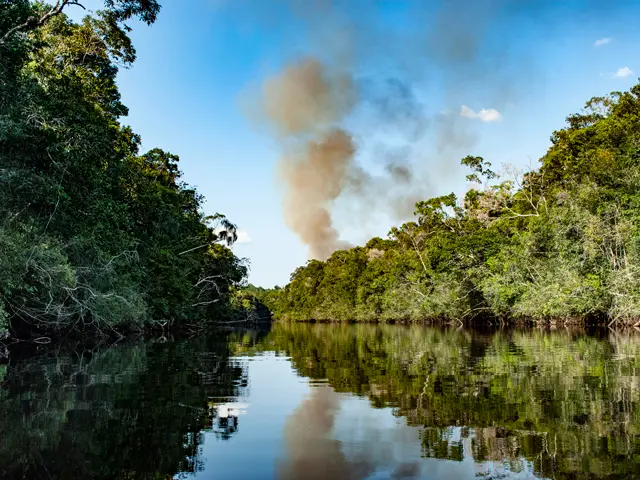
The Signature of Discord in Pirá Paraná
For the current authorities, the way in which Masbosques promoted the project—in their words “through document ploys and fraudulent maneuvers”—violated their fundamental rights. According to them, the NGO negotiated with several captains individually, in addition to the one who was no longer the legal representative of Acaipi, but never sought out the Indigenous Council, which has been the highest authority in Pirá Paraná since May 2019.
The Indigenous Council is made up of 23 people: the same 17 captains who make up Acaipi—one for each of the Pirá Paraná communities—plus six traditional sages who represent the different Indigenous peoples living there. The creation of the council fulfilled an old dream of becoming territorial entities with political-administrative functions, a promise of the 1991 Constitution that has been implemented in stages. In a 2018 decree, the Santos administration set out the route for the Indigenous territories in the non-municipalized areas of Amazonas, Guainía, and Vaupés, to be incorporated into the national ordinance with a category similar to that of towns. From that moment on, the territories began to create and formalize their councils, which are the figures of local government assigned to them by the Constitution, like the mayor would be in a town.
That means that, although today Acaipi and the Indigenous Council coexist, the latter is in the process of replacing the former and will be not only the internal governing body, but the one who will administer and execute public resources directly.
“The Indigenous Council is the maximum authority, the last instance of government of the Pirá Paraná territory,” Makuna leader Fabio Valencia told this journalistic alliance. Valencia is the council’s current legal representative and one of the two authorities who filed the writ for protection action. “Every time a program or a company arrives intending to operate within the Pirá Paraná, it must be presented at that level of government. But Masbosques never went there.”
“It’s not a question of negotiating directly with some communities, but of respecting the protocol we have for concertation. Community authorities and, above them, traditional ones, compose our sole decision-making instance. They are the ones who make a spiritual study and guide the captains towards a decision”, Wilmer Gómez, captain of the Toaka community told this alliance.
For the plaintiffs, Masbosques should not have disregarded the hierarchy of the Indigenous Council. “It was public knowledge in the records [of the Ministry of the Interior] from the date on which the registration became effective” in April 2020 and “is binding for public and private entities from that moment on,” they told the judge.
“It is a constitutional imperative and a fundamental duty of obligatory compliance for the state as well as for individuals who intend to relate to Indigenous peoples to respect both the Indigenous Council and its regulations, since both are enshrined in the Constitution," says Juan Carlos Preciado, a lawyer and expert on Indigenous issues who has been providing legal advice to the Pirá Paraná authorities through the Gaia Amazonas Foundation. "When entities such as Masbosques seek to establish a project or program with the Indigenous people, they must do so through their own system of government, which in the case of Pirá Paraná is the Indigenous Council as the highest representative body of the peoples and communities of that territory”.
Despite this, the project’s PDD never mentions the Indigenous Council, and instead speaks of cabildos as the “organization that interacts governmentally with the State on behalf of the reservations and is conceived as a special public entity”. “There is no cabildo here. We are an Indigenous territory, and its legal representative is the Indigenous Council,” said Valencia. The NGO acknowledged that it had not seen that part of the document, and that “there may be an error that would have to be reviewed.”
Masbosques defended itself during the legal proceeding, assuring that it has always acted correctly and that it signed the contract with whoever was the highest legitimate authority at the time.
It points out that on March 2, 2021, the authority was Acaipi and that the Ministry of Interior officially recognized Benjamin as its legal representative since December 2018. It also reasons that the national government did not register the Indigenous Council in April 2020, but only in July 2021. “These two actions were subsequent to the signing of the mandate contract with Masbosques and in a reckless manner the plaintiffs altered the dates in order to generate confusion in the subsequent process,” they told the judge.
In the same document, Masbosques acknowledges that Benjamin ceased to be the legal representative of Acaipi on March 24, 2021 and attributes its opponents’ discomfort to decisions taken “in the transition period between the election of the new representatives and the issuance of the administrative acts perfecting said election”, time in which it does not believe that the current authorities had “effective capacity of representation”.
“When I signed the mandate, I had my resolution and it was active at the date of signing,” Jhon Fredy Benjamín defended himself, telling this journalistic team that the contract was made “with the communities’ prior knowledge” and after multiple rounds making it known. Masbosques supports this version. According to them, the fact that the day after that contract Benjamín signed another one on education matters with the state government proves that, as their lawyer Juliana Noreña says, “he was recognized as president of Acaipi.”
Regardless of who is right about when the change came into effect, the technical documents that support the project show that the NGO did continue to use the name of the previous legal representative after the signing of the contract and the change of leadership.
On Baka Rokarire’s PDD, which can be downloaded from both Renare’s and Cercarbono’s platforms and says it was prepared on December 22, 2021, lists Jhon Fredy Benjamín as Acaipi’s current legal representative. That is nine months after the Interior Ministry officially validated the change of authority which Masbosques said it was aware of.
Interviewed by this journalistic alliance, Masbosques said that this was the legal reality when the project documents were prepared and that for the second phase “this adjustment must be made”.
When asked what they consider to be the highest governance instance in the Pirá, their Redd+ project coordinator, Mauricio Aristizábal, said that it was the captains and the communities, who answer for any problems in the territory, as well as Acaipi, who brings them together. “We have tried to respect the cosmogony and the way they organize themselves,” he explained, adding that captains—and their opinions about the project—can change suddenly and sometimes unpredictably.
Regarding the Indigenous Council, Aristizábal recognized its existence as a third instance, “a figure that is in the process of formalization” and that “not to say it is a bad initiative, but it has generated a fracturing within the association [Acaipi].” “Although we know that Fabio Valencia is its highest representative and we have taken him into account and tried to approach him, the communities are still not very sure if he is the one who is going to be the definitive representative of this council or not. And they have yet to perfect the way in which they present themselves before the agencies that give them recognition,” said their lawyer Juliana Noreña.
In any case, Masbosques contends that it carried out outreach meetings of the project with these three levels of government, both before and after the contract, insisting that its central work is with the communities. “We do not enter into political discussions. We are supporting an exercise that we want to carry out directly with the communities, and if the associations want to accompany us, it would be wonderful and valuable to have them,” Aristizábal explained.
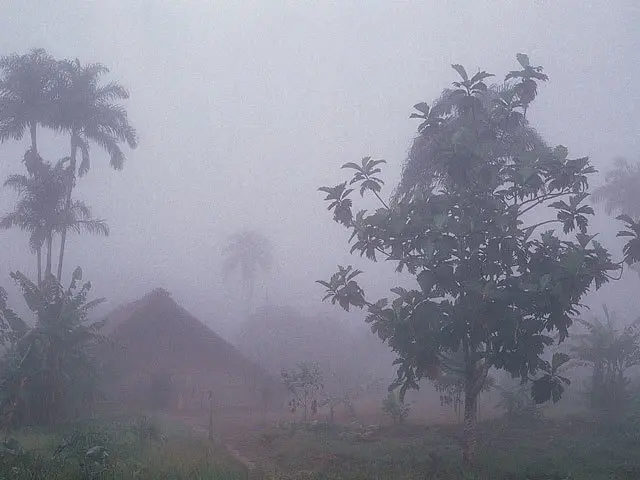
By the plaintiffs’ account, the communities are equally divided. By the opponents’ account, twelve are in favor of Masbosques and five are against.
“People do agree with the project. They requested it in view of the needs of a territory that the Colombian state has never paid attention to: schools and health centers are not in good condition, traditional malokas are falling apart piece by piece,” Eduria leader Leovigildo Benjamín, captain of Sonaña in the upper Pirá, told this journalistic alliance. For him, the resources of the Masbosques project—promoted by his uncle Jhon Fredy and his father Faustino—are more tangible than other Acaipi plans that have yet to materialize.
“We who have the knowledge of the jaguars of Yuruparí, in a vision of yagé were showed that it was prosperous,” he added.
Leaders critical of the project, who say they found out about the contract two months after the first credit sale, resent the low participation of the communities in the project’s operation. “It’s in Acaipi’s name, but the ones distributing and planning are them, Masbosques. They are the ones who are selling carbon credits to large companies, the ones who manage the accounts and, regarding sales, we don’t know the prices of the tons of carbon being negotiated,” says Fabio Valencia, adding that his first interaction with the NGO was after the mandate of the Indigenous Council to file the protection action. “We don’t know anything, but it’s still being done on our behalf.”
Masbosques disagrees, saying that—although they do not have a precise number of how many outreach meetings they carried out and in how many communities – they involved the majority, beginning in 2018. “We did not go directly community by community, but rather did nucleated engagement campaigns: one in Santa Isabel, which collects those of the lower Pirá, in Sonaña for those of the upper part, in Piedra Ñi for those of the middle part,” said Aristizábal, citing the difficult access by air and river as the biggest obstacle. As proof of their good faith, he said that they have an office in Mitú, a team of ten people for the Redd+ projects, and two Indigenous leaders from Pirá hired locally.
After the interview, Masbosques sent this journalistic alliance a folder with the minutes of meetings and voluntary agreements with a dozen communities, all signed between May and July of this year. A single attendance sheet—from a meeting with 26 people in Sonaña in December 2021—is dated before the project’s official registration. They also included a handful of photos of engagement meetings and activities dated by them as happening in 2021.
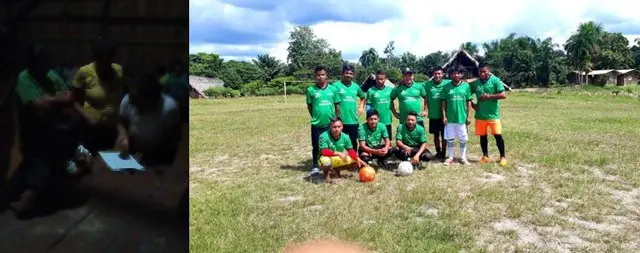
That is why, according to the NGO’s lawyer, Noreña, they were surprised when they were notified of the legal action after the project had been approved, the credits sold, and the first disbursements made. “They were so aware of it that a formal waiver of the mandate contract never arrived. They had full knowledge, and we truly don’t understand the discontent,” she says, adding that the project’s funds are in a Bancolombia trust, including those of the five opposing communities.
Part of the problem is that Acaipi and the Indigenous Council had been working since 2018 to design a different Redd+ project, in collaboration with the other three territories with whom they share the Yuruparí jaguars: Tiquié on the border with Brazil, Yaigojé-Apaporis just to the south, and Mirití-Paraná further down in Amazonas. Helping them structure that project is the Gaia Amazonas Foundation, one of the oldest environmental NGOs in the country. Its founder, ethnologist Martín von Hildebrand, was who—as Indigenous affairs advisor to President Virgilio Barco in the 1980s—promoted the pioneering policy of creating collective Indigenous territories which brought 200,000 square kilometers of Amazon rainforest under this form of governance. In addition to Gaia, they were expected to be supported by the environmental NGO Fondo Acción, which works with some 20 afro-descendant community councils on Redd+ projects in the Pacific, the climate consultancy Climate Focus and the non-profit investment fund Acumen.
The project promoted by Masbosques is in direct tension with the one called ‘Jaguares de Yuruparí Macro-Territory’, given that two different carbon offset initiatives cannot take credit for the same positive result in terms of avoided deforestation, for it would amount to double counting.
At a meeting of the Indigenous Council in San Miguel in July 2021, both appeared on the scene. After legal representative Fabio Valencia presented the advances in the project with Gaia, leader Faustino Benjamín proposed another one on Eduria lands with an unidentified intermediary company, according to the minutes. In the end, the six elders recommended not to divide the Pirá Paraná territory and all agreed to “avoid developing projects that have not been agreed upon and approved by the Indigenous Council”, according to the same document.
According to their promoters, one of their differences is that Gaia’s project – which had been approved by the Indigenous Council in September 2019 at Piedra Ñi—seeks that Indigenous people run it and choose the buyers, as some communities of the Colombian Pacific working with Fondo Acción do today, and that all the revenue it generates is then destined to consolidating Indigenous territorial entities. “Gaia does not gain any percentage of the profits nor does it even manage the resources, but supports the political strengthening of the Indigenous people to implement it and the administrative strengthening to execute it,” explained its director Francisco von Hildebrand. “While in the voluntary carbon market they talk about profits, we talk about state building and effective political participation of Indigenous peoples to build a different model of development and environmental governance for the region, in which the [carbon] money is just one part.”
“We don’t need a company to come and say, on our behalf, what they want to do, but we as a government should negotiate and reach agreements with the companies,” says Valencia, who is also captain of Santa Isabel in the lower Pirá and since August this year also Acaipi’s legal representative. For Leovigildo Benjamín, it is the current model that has brought them economic independence. “Having access to the resources directly as captains began with the Masbosques project,” he says, adding that in the other scheme they depended on Gaia.
This influx of cash seems to have persuaded several of the leaders who initially opposed the project, including one of its plaintiffs. “I realized that the people in the communities have another vision and needs that have nothing to do with the political process we are envisioning and are not covered by it,” Jesús León, Tatuyo leader and rector of the Piedra Ñi school who led Acaipi until August, told this journalistic alliance, adding that he met with Masbosques two weeks ago. “The project has the capacity to support these processes, if we manage it in the right way,” he added. Days later, León wrote to the judge asking him to terminate the legal action, arguing that the facts he had alleged had been overcome.
All three, in any case, acknowledge that the governance structure of the territory has suffered with the divisions regarding the project.
Complications
The Pirá Paraná is not a resguardo but its territory is part of a larger one, the Gran Resguardo del Vaupés, which—as its name suggests—covers almost the entirety of this Amazonian department. There are 3.9 million hectares of jungle, an area slightly smaller than that of Switzerland or the Netherlands, where 19 Indigenous peoples live together in a true multi-ethnic mosaic.
It is also a mosaic of active and emerging Redd+ projects, including two more from Masbosques. The largest portion of the resguardo—11 of its 17 associations of Indigenous traditional authorities (AATIs)—is linked to another project that has also generated divisions within its communities. Its promoter is the Colombian company Waldrettung S.A.S., which claims to be a subsidiary of a German firm that does not appear in that country's commercial registry, as revealed in an investigation this year by Rutas del Conflicto, Mongabay Latam, La Liga contra el Silencio and CLIP. In fact, its legal representative Helmuth Gallego insists that those six remaining AATIs should not be able to develop Redd+ projects individually, but only with whoever has a contract with the resguardo's own government. That is, with his company.
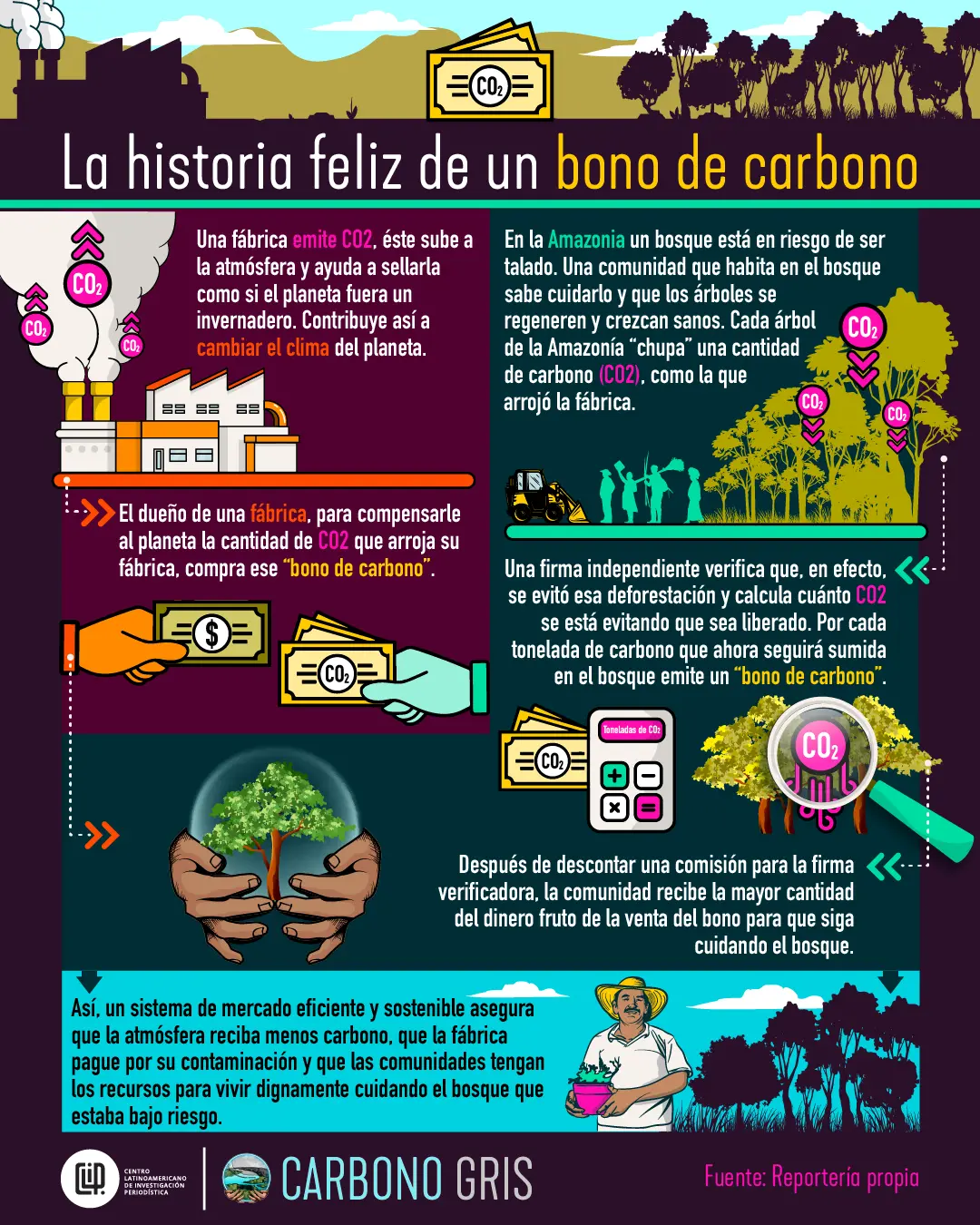

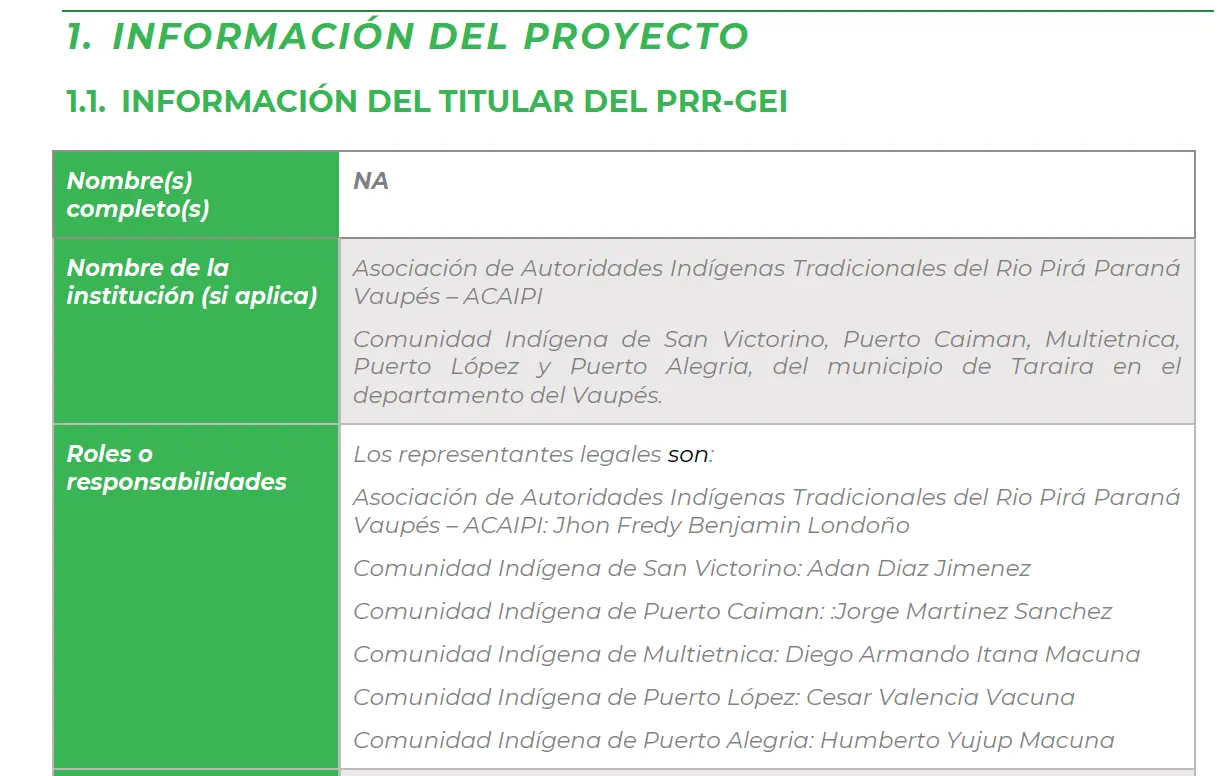
A Legal Action Against the Entire Carbon Chain
Beyond the discussion about the date, the Indigenous Council considers that the validation process of Baka Rokarire shows problems along the entire carbon credit chain, in which theoretically the different actors should act as checks and balances to ensure that the projects comply with the social and environmental standards promoted by the UN and the Colombian government.
Therefore, considering that they were negligent in not identifying these flaws at the onset of the project, they also directed their legal action against the certifier Cercarbono, the auditor Ruby Canyon Environmental, and the consulting firm Soluciones Proambiente S.A.S., which helped prepare the PDD.
A look at the project validation process shows that Ruby Canyon Environmental’s auditors did not visit the Pirá Paraná communities in person, which may explain why they missed the concerns of some of their leaders.
According to its report, its two employees were unable to do so “due to particular circumstances that arose in and around the project area, related to the activity of armed and criminal groups that generated violence during a period that included the dates of the site visit.” As a consequence, says the document, “the visit had to be adjusted and conducted in a way that included two main activities”: a meeting in October 2021 in the departmental capital of Mitú with eight leaders brought from the territory, and overflights of the project area. Their report, dated February 2022, also speaks of Jhon Fredy Benjamin as Acaipi’s current legal representative—eleven months after he had been replaced.
Ruby Canyon did not respond to an email asking if their site visit limited by the security situation may have prevented them from speaking with other community leaders and hearing their concerns.
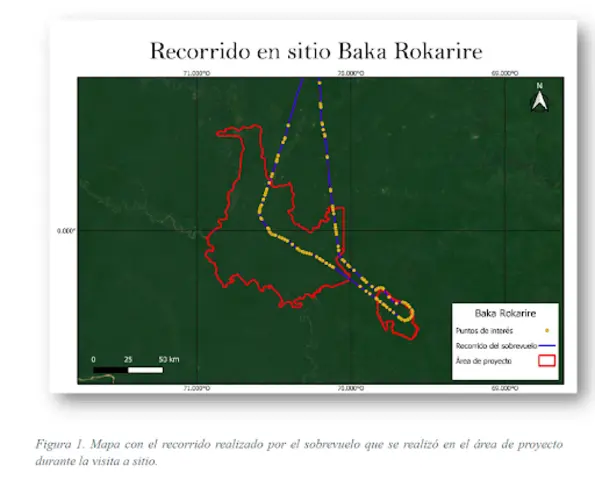
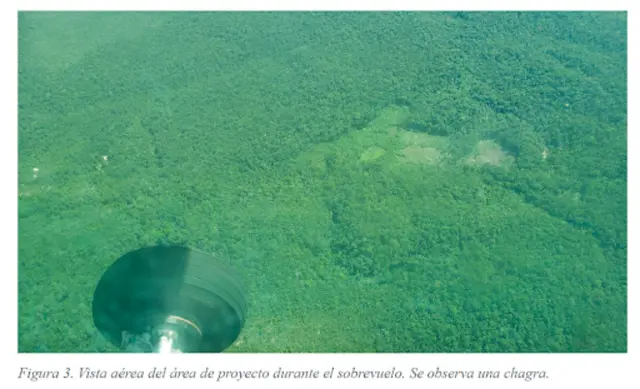
The authorities of the Pirá Paraná also filed their suit against the Institute of Hydrology, Meteorology and Environmental Studies (Ideam), the government agency that monitors deforestation in Colombia, and its parent institution, the Ministry of Environment, on the grounds that they have failed to supervise the project. “It is necessary that the regulations on the operation of Redd+ in Colombia incorporate human rights standards, as it is not constitutionally viable that the measures called to protect them in environmental matters actually do the opposite,” they wrote.
These standards have existed—under the name of social and environmental safeguards—since the UN climate conference in Cancun in 2010. But, although the Colombian government developed a detailed interpretation of these ground rules at the national level, it has not made them mandatory for private projects.
If the allegations of the Indigenous Council are found to be true, according to four persons with knowledge of environmental issues and the carbon market, Baka Rokarire could be in breach of several national safeguards, including those on full participation and free, prior, and informed consent of communities, as well as one stating that projects should recognize and strengthen existing forest governance structures.
The Environment Ministry said to the judge that “the registration of the information in Renare does not imply responsibility of any kind on the part of the Ministry,” but rather on the part of the private parties that upload the information, adding that it would not make a substantive pronouncement on the facts because it was not aware of them. Ideam answered similarly, adding that regulating Renare to include guarantees of the rights of Indigenous peoples is beyond its purview.
Masbosques differs from the Indigenous Council’s version. “Everything that the plaintiffs seek to annul is permeated by an unwavering presumption of legality,” wrote its director Jaime García Urrea in his response to the judge, noting that his organization tried to arrange multiple meetings with the current authorities both in person and by telephone, in Mitú and in Bogotá, but that they never attended.
A major part of their defense revolves around the economic benefits that the project has already brought the Indigenous people, explaining that—of the 15,293 million pesos from the first bond sale—4,823 million had already been received by ten Pirá Paraná communities and 2,031 were still pending delivery. Another 3,641 million pesos had been transferred to the five communities of Taraira that share the project. “Personal interests cannot affect a project that represents a set of economic development alternatives for the communities that do not involve deforestation and at the same time provides forest protection in the face of a need to protect and safeguard the country’s strategic ecosystems,” Masbosques wrote. The NGO did not detail the total amount of the sale and its lawyer assured that they do not take a fee for their role as intermediaries.
The Indigenous plaintiffs have already lost the first round. First, on August 2, Judge David Parra of the criminal circuit of Bogota dismissed their legal action because, in his opinion, they did not demonstrate that they had no other recourse than the protection action and that they had “a variety of ordinary, efficient, suitable and even one of them expeditious mechanisms to settle the contractual controversy”, suggesting they file a class action. Judge Parra also questioned the urgency of the case, asking why they waited a year to initiate a legal process and did not desist from the project. The Pirá Paraná authorities challenged the ruling, arguing that this is a constitutional matter and not a contractual one.
The case went to a second instance judge, in the Superior Court of Bogotá, who on September 7 declared the previous ruling null and void and sent it back to the first judge. In its view, there was an improper proceeding because the first instance judge had not linked the Indigenous affairs directorate of the Ministry of the Interior, the Inspector General’s Office, and the Ombudsman’s Office to the process. The three entities said they had no relation with the case, including the Ministry, which pointed out that these are matters “within the purview of other authorities”.
Thus the case returned to Judge Parra, who on September 26 ruled for the second time and, using similar arguments, again declared it not admitted. The Indigenous leaders again challenged the decision and the case returned once more to the Superior Court of Bogotá, which also ruled against them last Friday on the argument that it was a matter for civil or administrative judges, although it also referred the case to the Attorney General's Office to investigate the matter. With this second adverse decision, they may try to reach the court of last resort on constitutional issues in the country.
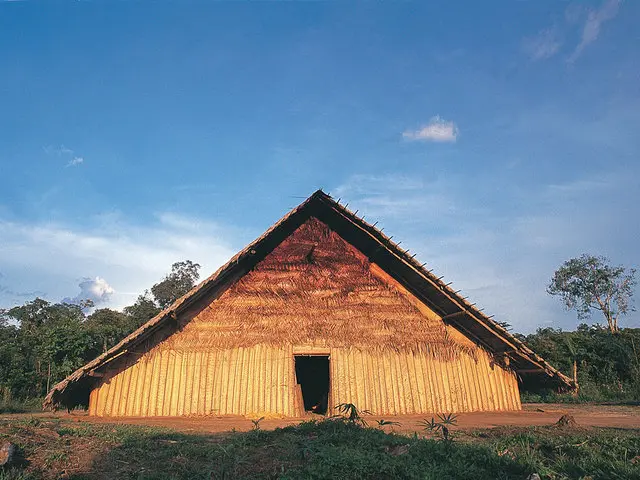
Pirá Paraná’s Credits Fly High
While the legal action of the Pirá Paraná authorities advances in court, their carbon credits have taken off.
According to what Masbosques told the first instance judge, the Baka Rokarire project completed its first sale of carbon credits on March 31 of this year to Latin Checkout. The 15,293 million pesos (some US$4 million) that the company paid are the resources that the NGO began to distribute to the 22 communities that make up the project.
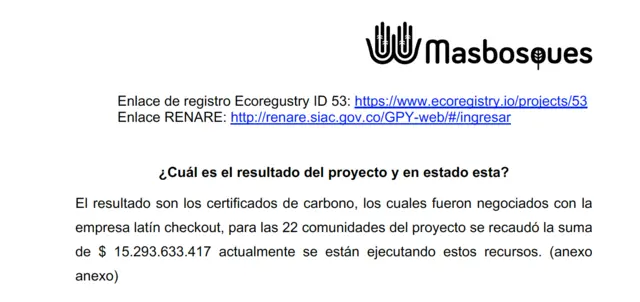
Although it does not have a website, Latin Checkout S.A.S. is a company registered in Medellín in 2016 with the purpose of providing logistics and customer service to international online stores, marketing goods on the internet and, since a change of statutes in 2019, also storing, processing, and analyzing data. It was this company that developed the EcoRegistry platform with blockchain technology, where Cercarbono advertises all projects using its Redd+ standard. (Its partner in developing this tool, the company XM, which is a subsidiary of the energy giant ISA, announced the sale of its shares in EcoRegistry to Latin Checkout in September of this year). This is relevant because Cercarbono was the certifier of the amount of carbon emissions removed by Baka Rokarire and, as such, the legitimacy of the transaction depends on its independence from the chain of actors involved in the Redd+ project.
This is not Latin Checkout’s only link with the certifier that registered the Pirá Paraná project and issued its carbon credits. The three founders and partners of Latin Checkout—originally called Cotrucel S.A.S.—are the same ones who have led Cercarbono: Carlos Trujillo Echeverri, Alejandro Celis Posada, and Andrés Correa Agudelo. Correa is Latin Checkout’s legal representative and Celis is its technology manager and alternate representative, while Trujillo leads Cercarbono. As of January 2022, all three were on the certifier’s board of directors.
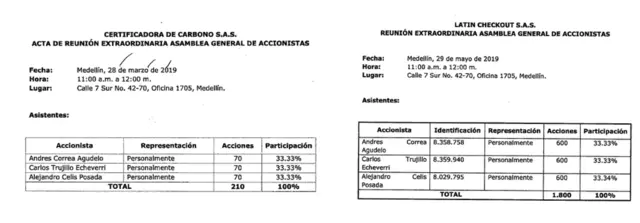
Until 2019, both companies shared the same address: office 1705 of the Forum Building, in the Poblado neighborhood of Medellín, according to their chamber of commerce certificates.

Six months later, between the dates on which the judge of the Superior Court of Bogota sent back the legal action and the first instance judge ruled again, the 1.3 million carbon credits issued by Baka Rokarire were withdrawn.
Yet they weren’t withdrawn by Latin Checkout, but by Delta Airlines, as reported by the EcoRegistry platform dated September 19.
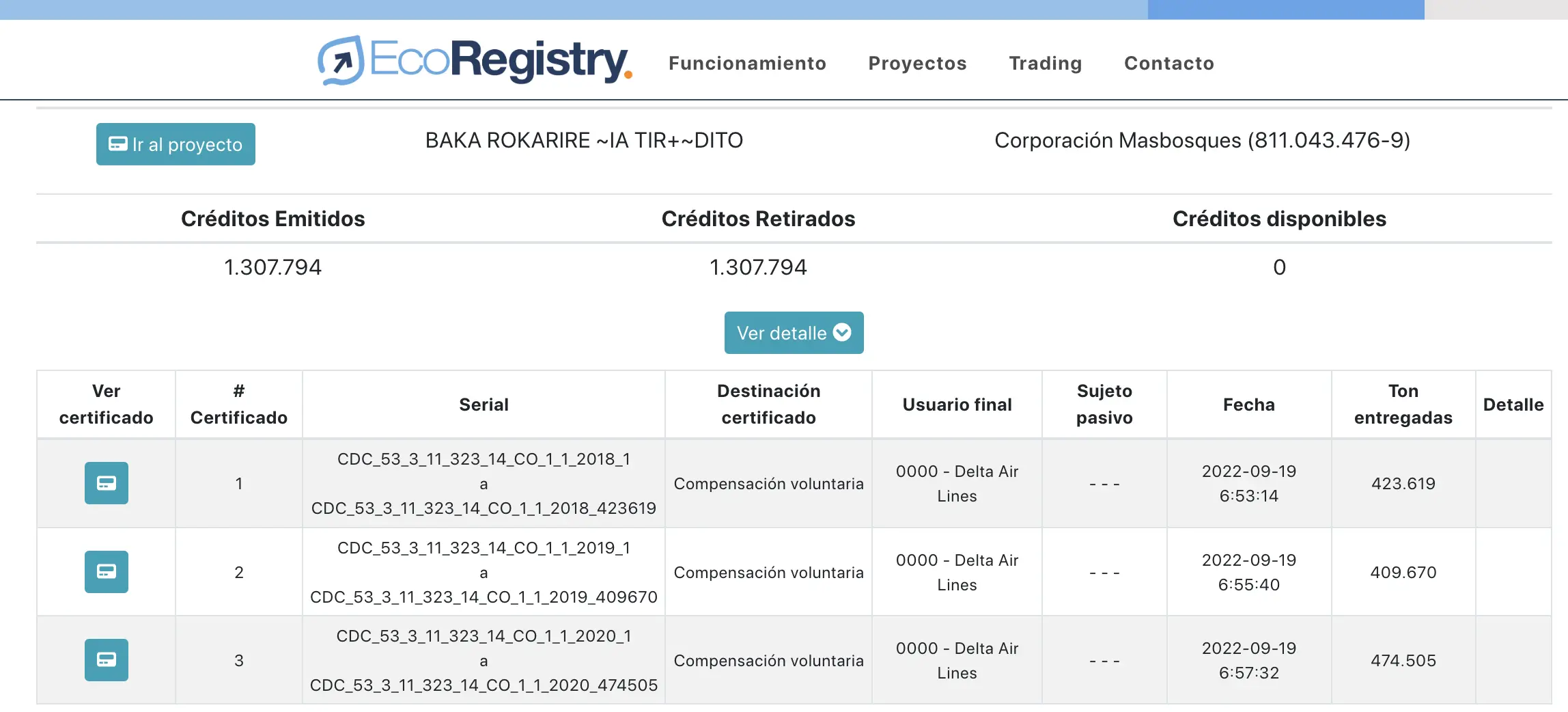
Masbosques confirmed that the sale was made to Latin Checkout and that it does not know the conditions under which they were transferred to Delta as that was, in the words of Mauricio Aristizábal, “an external negotiation”. Aristizábal explained that the trader was Soluciones Proambiente S.A.S., a consulting firm from Itagüí that helped formulate the PDD of Baka Rokarire and that was founded by Mauricio Fernández Posada as sole shareholder in June 2020.
When asked if Masbosques kept part of the resources, lawyer Juliana Noreña explained that 60 percent of the income corresponded to the 22 communities of Vaupés and the remaining 40 percent to Soluciones Proambiente as project funder, once administrative costs such as field trips, human resources, and its office in Mitú were deducted. “Masbosques does not make any profit from these projects, what we gain is experience and recognition in the area,” she said.
Andrés Correa of Latin Checkout told this journalistic alliance that his company “helps maximize income for all projects” in EcoRegistry and that among the services it offers is “marketing and technological integration with payment gateways and credit trading platforms.” However, he denied that Latin Checkout had sold the Baka Rokarire bonds to Delta, saying that “to date we have not carried out operations with this company.”
Correa also said he is not a shareholder of Cercarbono. The company’s official minutes, registered with the Chamber of Commerce, show that he was a shareholder, at least between 2016 and 2019, and other documents show that at the beginning of this year he was still a board member. Asked about the amount paid for the credit purchases made by his company, he said he would only share the information with prior authorization from the communities. He also did not answer to questions about who the credits were sold to, if not to Delta, and how long was he a shareholder of the certifier.
Cercarbono, through its communications director, told this alliance that as a matter of policy it does not comment on “different processes that the projects carry out and that lay outside the certification process” and that it is up to the courts to rule on the legal action against Baka Rokarire. The company did not answer whether its manager Carlos Trujillo is still a shareholder of Latin Checkout, but explained that “they are companies with a different corporate purpose and whose only relationship is the commercial one derived from the services provided by Latin Checkout, which do not influence the certification standards of the Cercarbono program”. He added that Latin Checkout is a provider of technological services for Cercarbono, by operating EcoRegistry, and “helps in the trading of credits for some Cercarbono projects”, although he did not specify which ones.
Mauricio Fernández confirmed that Soluciones Proambiente is the formulator and funder of the project in Pirá Paraná. He explained that he would not comment on the legal action, explaining that their company vision “is and will always be respect for the law, autonomy and the cultural integrity of Indigenous communities and their traditional authorities”. He did not answer any specific questions about the financing of the project, including how much he invested in its formulation and implementation, what percentage of the revenue from the sale of credits corresponded to the company he represents before and after deducting those operating costs, or whether the Pirá Paraná communities were aware of his role as funder. Nor did he provide information on what other Redd+ projects his company is involved in financing.
Finally, we asked Delta Airlines how they assess the quality of the credits they purchase and whether they knew that the project whose credits they used had been sued by the current Indigenous authorities two months earlier. At the time of publication, they had not answered.
What is clear from the information available is that those who first bought the carbon credits are the same ones who registered the project and certified the amount of carbon not liberated to the atmosphere. And that, despite the project being developed by a non-profit environmental corporation to bring resources to Indigenous people, there is also a company that has taken a portion of the profits (40 percent of the income, minus costs, according to Masbosques’ lawyer).
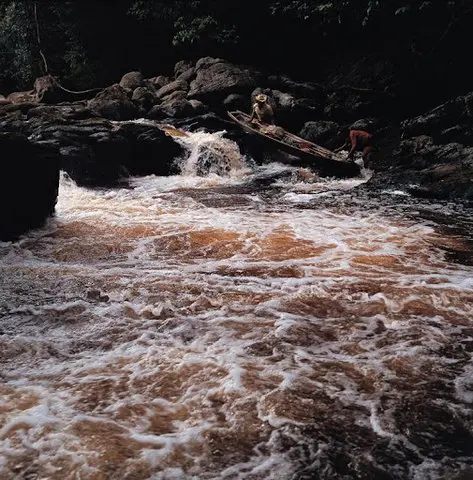
Carbon in the Court
Until now, the justice system has interpreted the conflict from the more limited perspective of a contractual dispute between two private parties. That could change if the justices of the Constitutional Court choose to examine this case, as permitted by the Colombian justice system and as sought by the Indigenous people of the Pirá Paraná Indigenous Council.
For this to happen, the plaintiffs can make a selection request now that they have exhausted previous instances. Each month, two of the Constitutional Court nine justices sit—on a rotating basis—in a special chamber that selects those cases that they believe the highest court should examine, either because of their constitutional relevance, the novelty of the issue or the need of taking a differential focus into account. In a typical month there may be 150 applications.
If their case is not chosen, they have a second option: in the following two weeks, an appeal may come to the Court, which would be examined by the judges of the next selection chamber. This step, however, can only be taken by the Ombudsman’s Office, the Inspector General’s Office, the State Legal Defense Agency, or the justices of the Court themselves, so the Indigenous leaders would need to persuade one of those four to submit it. It’s a scenario in which they would depend on a third party, although it could play in their favor that the Constitutional Court tends to prioritize unusual problems without precedent to create jurisprudence (although, after the 2019 conviction of former magistrate Jorge Pretelt for corruption, the court has tried to reduce the margin of subjectivity of these selections and set guidelines that seek to ensure that they really have a constitutional interest).
One more factor could play in their favor: the Pirá Paraná shares a border—along a hundred kilometers—with the Yaigojé-Apaporis National Park, one of the largest in the country and the epicenter of a resounding and novel legal dispute over Indigenous rights that was resolved precisely by the Constitutional Court.
In that case, an Indigenous association that had declared itself in dissidence from the one that had governance in the area sued the creation of the national park—the first in Colombia to be managed by ethnic communities—arguing that it had not been consulted by the national government. At the beginning of the hearing convened by three Constitutional Court justices in the jungle in 2014, the leader of the plaintiff association asked to speak and surprisingly confessed that his legal strategy had been organized and paid for by the Canadian gold mining company Cosigo Resources. The reason was that the mining title granted to them by the government one day after the designation of the park would only become effective if that designation, which preceded it in time and legally prevented mining, fell through. In its ruling, the Court—which has great legitimacy inside and outside the country—made it clear that there was undue interference by the company and left the national park in place.
Not only that ruling was considered a milestone. The jungle hearing, which involved taking the magistrates by helicopter and their teams by river a week earlier, has been considered by international constitutional scholars as an example of the “proactive approach” of the Colombian Court which, with on-site visits to remote places such as the Amazon or the Darien Gap, has allowed it to “develop the transformative role of its jurisprudence.”
One of the points that the Constitutional Court could end up examining, if it takes up the case, is whether carbon projects are businesses between private parties in which the State should not intervene or whether, on the contrary, the State has a duty to accompany the Indigenous or Afro communities that negotiate with companies and to supervise that these comply with certain minimum conditions.
Under the government of Iván Duque, the Ministry of Environment defended the view that a Redd+ project is “a private initiative and, therefore, it is governed by the legal framework that assists it as an entity that exercises a commercial activity under private law”, and that the Ministry “has no competence to advance supervision over the management of such resources,” as it declared to CLIP in a story about another case of carbon credits in the Matavén reservation, published before the change in national government. Others, however, argue that public law should also be considered, because while the reservations are figures of collective private property, the exercise of authority by Indigenous peoples is public in nature. “It is not an issue of the character of the land, but of who intervenes in the process, and they are public authorities,” says lawyer Juan Carlos Preciado.
The new government of President Gustavo Petro has expressed a friendlier stance towards the regulation of the carbon market. Although it has not yet announced measures, Environment Minister Susana Muhamad has defended that payment for environmental services schemes are needed to incentivize the care of the most sensitive ecosystems, but that they should be awarded—in her words—“with regulation because today we’re in the Wild West with respect to carbon credits.”
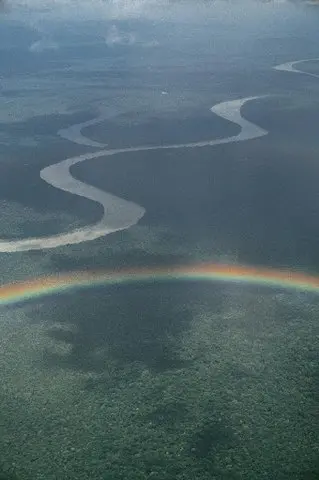
Additions and Subtractions
Regardless of whether Masbosques’ case reaches the Constitutional Court as the Indigenous Council would like, one of the effects of the Baka Rokarire project seems to have been a deep internal division in the communities of the Pirá Paraná.
“This disorder has generated a weakness and a rupture in the process we have been building for a long time. There is a risk that everything could fall apart,” says Makuna member Wilmer Gómez. “What the people are asking here is what are we doing, are we building a territorial entity or just finding companies that give us the money in the easiest way? What is the commitment of the Indigenous government of Pirá Paraná? And if we don’t understand each other, what are we forming a territorial entity for?”, adds Fabio Valencia.
The reflection of the two captains is echoed by people who have been working in the Colombian Amazon for decades, who fear that these economic incentives could—paradoxically—weaken ethnic governance of these strategic ecosystems instead of strengthening it. “Territories with a cultural unity per group or cultural complex are being fractioned by these negotiations,” says a person who has observed it firsthand in a nearby department and asked for their name to be omitted because of the sensitivity of the issue in the environmental sector.
“Acaipi is, no doubt about it, a crowning achievement in Colombia’s Indigenous governance model. One of its great triumphs is an educational system in which the young learn from their elders and in this way perpetuate traditional knowledge and therefore the integrity of the people and the forest,” says anthropologist Stephen Hugh-Jones. “Creating divisions among a territory that has historically had awareness of its common identity and a willingness to cooperate is catastrophic.”
Masbosques believes the conflict precedes them and is not due to their project. “Fragmentation can happen whether we are there or not. It has always existed,” says Mauricio Aristizábal, adding that the Antioquia-based NGO has been the victim of “a lot of intrigue and troubled waters in which we have been involved.”
The multiplication of conflicts over carbon credits is occurring under the unconcerned eye of the Colombian state, which is not supervising the implementation of private projects or investigating possible irregularities in them. This journalistic alliance asked the Environment Ministry what actions it has taken since learning of the legal action and whether it had made use of its powers under the recent Climate Action Law to request an investigation into this case, but at the time of publication it had not responded.
In this breeding ground, what was thought to be a solution to bring money to the Indigenous people of the Amazon and reward their decision to protect the forest could end up being a bonanza as ephemeral and divisive as rubber.
Note: You can see this research in its Spanish version here.



